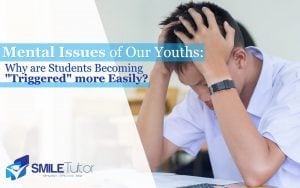
“Why are today’s kids so angry all the time?” I’ve heard a grandma lament once.
Today’s kids are what we commonly refer to as Gen Zs. Living in a world bustling with entertainment, youths today are precocious, hyperactive and always in-the-know.
Which is why grandma seems to have touched on something important.
Many cases involving the misdemeanours of minors seem to surface on the news every once in a while. From something that started as irritability, youths can feel compelled to act out their frustrations and turn their thoughts into an ultimatum, ending in actions of violence.
Of course, not every youth acts compulsively to their darker emotions. But it remains a cautionary tale that we must hear to understand.
So this begets the question: Why are more students becoming “triggered” more easily? Why does it seem like they’re more confrontational, and more easily provoked all the time?
Whether you’re a concerned parent, a teacher struggling to understand their students, or simply a friend you believe to be overly angry all the time, these are all reasons to want to demystify the reasons for their frequent emotional outbursts.
Why is This Important?
Is aggression among youths such an important topic? Well…
Singapore’s Youths Are Not an Exception
Heard of the school shootings in the States? Survey findings show that their aggression tends to come from retaliating from their lowest points in life. This can stem from bullying to parental neglect.
While it’s not entirely applicable to Singapore’s vastly contrasting culture when compared to the west, we too have lessons to learn from these unfortunate incidents.
We cannot downplay the consequences of unaddressed violent thoughts amongst youths!

From a radicalised youth attempting a terrorist attack, to a girl who resorted to stabbing after a verbal confrontation, or even spreading hate speech, these incidents have actually occurred within Singapore! Does this not paint a picture of the extreme tendencies that youths are capable of?
And so this brings us to a conversation point: Why do you think aggressive behaviour has become such a common sight amongst youths? They’re easily moved by the slightest inconvenience at times, and may feel offended at words that were not even spoken for provocation.
Are our youths really just the strawberry generation? Or is there something else that has sculpted their mannerisms and behaviour?
The Influence of Social Media
It is to no one’s surprise that the rise of social media has a big part to play when it comes to the way students interact and process information. As such, it is not an unfounded belief to claim that online platforms often encourage impulsivity.
Watching Inappropriate Videos

Starting with YouTube, enter Elsagate, a now banned creator which popularised an extremely repulsive trend on the platform back in 2017. They targeted children as the main demographic, and had great success with engagement. Except, it’s the wrong kind of engagement. Popular cartoon characters were used in thumbnails and their skits, which disguised themselves as innocent children’s content.
But in truth, Elsagate stimulated younger minds with disturbing content that featured violence, sexual innuendos, and graphic imagery.
How badly this would influence kids at the time cannot be understated.
During their peak of popularity, Elsagate had successfully brainwashed many of them, with various uninformed parents remarking that their children had become “afraid” and more “playfully violent” while re-enacting the scenes in those videos.
Validation Through Online Presence

We’ve heard this one before. But even more than the past decade, the world has learnt to adapt to social media as a culture. If one is not seen with a social media account, they can often be considered as estranged, or the “odd one out”. It’s really hard for students not to attach themselves to an account and engage actively with others online.
Social media is that space to really express yourself. You’re free to post anything you want, and like anything you want, and this has fostered a culture of instant validation or backlash. Many who are trapped in its net, live by their likes and shares, and may often become defensive and possessive over their “public standing”.
This constant exposure to divisive and emotionally charged content can contribute to heightened emotional responses and trigger aggressive behaviour.
Developing ADHD
[Freepik]
Attention deficit hyperactivity disorder is something that youths are exposed to, the more they keep up with social media engagement. ADHD is one such trait that pushes these young individuals towards hyperactivity, and this increases their volatility in both actions and emotions, a defining catalyst for violence!
Sensory Overload and Stress

[Freepik]
Another commonality that ties itself as a cause for aggression is stress.
Stress has always been a commonality brought up by people when they attribute bad things to youths today.
Indeed, modern students face a myriad of academic, social, and personal pressures, resulting in heightened stress levels. In a 2017 study conducted by the Organisation for Economic Cooperation and Development (OECD), Singaporean students had their anxiety numbers polled way above the OECD’s average.
How very surprising. Couldn’t students handle the extreme academic demands, extracurricular activities and the family expectations that come along with it? All of this is “to be expected of youths today”.
Thinking that it may be them who’s abnormal and is falling behind in their studies, these students keep their grievances inside and endure, sometimes leaking their dissatisfaction with misdemeanours like truancy or faking illnesses to skip school.
Youths aren’t one to take punches in silence. It’s especially not in character for Gen Zs. When there is no outlet to vent their silent frustrations, they’ll DEFINITELY let you know about it!
Lack of Emotional Regulation Skills

[Freepik]
Children are forced to grow up too quickly.
Being exposed to the expectations and media around them, Gen Zs can find themselves without a walkthrough on something that can seem so simple to others. Schools don’t really teach empathy, but expect you to pick up social cues and adapt normally.
But not all students can do this. Identifying and managing emotions, or more commonly known as empathy, can become a lost practice. When they grow up with such deficiencies, these youths will become inept in navigating challenging situations in a healthy and constructive manner. Instead, they stick to what gets their voice heard the most: conflict.
If they can’t regulate their emotions or those around them well, the negative ones are always the first to rear their heads; anger, frustration, anxiety to name a few.
Trapped in Echo Chambers

[Getty Images]
Students form cliques, or like-minded individuals as friends. Sometimes, that’s not a good thing. When everyone wants to “blend in”, they lose part of their individualism, choosing to stick to the same perspectives that the group has formed.
In a similar connection to social media, the type of content they are exposed to regularly will also shape their thoughts.
What do you mean you don’t like Game of Thrones?
Are you saying K-dramas are boring?
As opinionated as youths are, they can become less tolerant of opposing views, and may feel personally attacked because of it.
Conclusion: Acknowledging a Difference in Thinking

[Freepik]
Like it or not, Singapore, like the rest of the world, is experiencing a generation gap with many of its societal issues. Many of them stem from the issue of miscommunication. This gap of communication leads to misunderstanding and disharmony among people.
A gap between the young and old, where mindsets have vastly different ideologies. For one, youths are full of passion and drive, and can often be considered to be risk takers. On the other hand, the old holds wisdom and experience, and thus may be seen to be more averse to risks.
When youths today are left without guidance, it can be easy for them to be isolated and pushed among the waves, perhaps landing on a shore that they may not have intended to.
From the impact of social media and sensory overload to the lack of emotional regulation skills and cultural expectations, we must understand that it is never one thing that leads to a student being aggressive.
Some issues may never be possible to resolve on an individual level, but it’s still important to acknowledge and address the culprits at their roots. Many youths are often misunderstood because of stereotypes, and this can create a self-fulfilling prophecy that breeds even more aggression.
Be understanding of our youths today, and empathise with their issues.
Only then, can we begin to approach them with help, and genuine care for their mental health.

